How To Make A Time Sensitive Graph On Excel
Charts aid you visualize your data in a way that creates maximum impact on your audience. Learn to create a nautical chart and add a trendline. You can offset your document from a recommended chart or cull one from our drove of pre-built nautical chart templates.

Create a chart
-
Select information for the chart.
-
SelectInsert >Recommended Charts.
-
Select a chart on theRecommended Charts tab, to preview the chart.
Note:Y'all can select the data y'all want in the chart and press ALT + F1 to create a nautical chart immediately, simply it might not be the best chart for the information. If you don't come across a chart y'all similar, select theAll Charts tab to come across all nautical chart types.
-
Select a chart.
-
SelectOK.
Add together a trendline
-
Select a chart.
-
SelectDesign >Add together Chart Chemical element.
-
SelectTrendline and then select the type of trendline you lot want, such equally Linear, Exponential, Linear Forecast, orMoving Average.
Annotation:Some of the content in this topic may non be applicative to some languages.
Charts brandish information in a graphical format that tin can help you and your audition visualize relationships between data. When you create a chart, you lot can select from many chart types (for instance, a stacked column nautical chart or a 3-D exploded pie chart). After you create a nautical chart, you can customize it by applying nautical chart quick layouts or styles.
Charts contain several elements, such as a title, axis labels, a fable, and gridlines. Yous can hide or display these elements, and yous can also change their location and formatting.
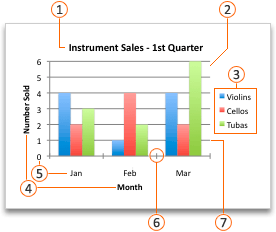
 Nautical chart championship
Nautical chart championship
 Plot area
Plot area
 Legend
Legend
 Axis titles
Axis titles
 Axis labels
Axis labels
 Tick marks
Tick marks
 Gridlines
Gridlines
You can create a chart in Excel, Give-and-take, and PowerPoint. Still, the chart information is entered and saved in an Excel worksheet. If y'all insert a chart in Word or PowerPoint, a new sheet is opened in Excel. When you salve a Word certificate or PowerPoint presentation that contains a chart, the chart's underlying Excel data is automatically saved within the Word certificate or PowerPoint presentation.
Note:The Excel Workbook Gallery replaces the former Chart Wizard. By default, the Excel Workbook Gallery opens when you open Excel. From the gallery, you tin browse templates and create a new workbook based on one of them. If you don't see the Excel Workbook Gallery, on the File menu, click New from Template.
-
On the View menu, click Print Layout.
-
Click the Insert tab, and and so click the pointer next to Nautical chart.

-
Click a chart type, and so double-click the chart you want to add.
When you lot insert a chart into Discussion or PowerPoint, an Excel worksheet opens that contains a table of sample data.
-
In Excel, replace the sample data with the data that you want to plot in the chart. If y'all already have your data in another table, you can copy the information from that tabular array and then paste information technology over the sample data. See the following table for guidelines for how to arrange the information to fit your nautical chart blazon.
For this chart type
Arrange the information
Area, bar, column, doughnut, line, radar, or surface nautical chart
In columns or rows, equally in the following examples:
Series 1
Serial 2
Category A
10
12
Category B
11
14
Category C
ix
15
or
Category A
Category B
Series one
10
xi
Serial two
12
14
Bubble chart
In columns, putting x values in the commencement column and corresponding y values and bubble size values in adjacent columns, equally in the post-obit examples:
X-Values
Y-Value 1
Size 1
0.vii
two.7
4
one.viii
3.ii
5
ii.6
0.08
six
Pie chart
In ane cavalcade or row of data and one column or row of data labels, as in the following examples:
Sales
1st Qtr
25
2nd Qtr
30
3rd Qtr
45
or
1st Qtr
2nd Qtr
third Qtr
Sales
25
30
45
Stock chart
In columns or rows in the post-obit order, using names or dates as labels, as in the post-obit examples:
Open up
High
Low
Close
1/v/02
44
55
11
25
1/vi/02
25
57
12
38
or
1/5/02
1/six/02
Open up
44
25
High
55
57
Depression
11
12
Close
25
38
X Y (scatter) nautical chart
In columns, putting x values in the start column and corresponding y values in adjacent columns, every bit in the post-obit examples:
Ten-Values
Y-Value 1
0.vii
2.seven
1.8
3.two
ii.6
0.08
or
10-Values
0.seven
one.eight
2.6
Y-Value 1
2.7
3.2
0.08
-
To modify the number of rows and columns included in the chart, rest the pointer on the lower-right corner of the selected data, and then drag to select additional data. In the following example, the tabular array is expanded to include boosted categories and data series.

-
To see the results of your changes, switch back to Word or PowerPoint.
Notation:When you close the Word certificate or the PowerPoint presentation that contains the nautical chart, the chart's Excel data table closes automatically.
After you create a nautical chart, you might want to change the way that table rows and columns are plotted in the chart. For example, your first version of a nautical chart might plot the rows of data from the table on the nautical chart's vertical (value) centrality, and the columns of data on the horizontal (category) axis. In the post-obit example, the nautical chart emphasizes sales past musical instrument.
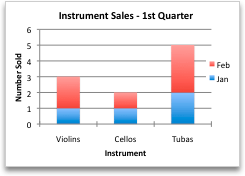
However, if you lot want the chart to emphasize the sales by month, yous tin can contrary the manner the chart is plotted.
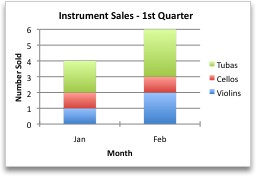
-
On the View menu, click Print Layout.
-
Click the nautical chart.
-
Click the Chart Design tab, and then click Switch Row/Column.

If Switch Row/Cavalcade is non available
Switch Row/Column is available simply when the nautical chart's Excel data table is open and merely for certain nautical chart types. You can too edit the data past clicking the chart, and and so editing the worksheet in Excel.
-
On the View menu, click Print Layout.
-
Click the chart.
-
Click the Chart Blueprint tab, and and then click Quick Layout.

-
Click the layout you lot want.
To immediately undo a quick layout that you applied, press
 + Z .
+ Z .
Chart styles are a set up of complementary colors and effects that yous can apply to your chart. When you select a chart style, your changes impact the whole nautical chart.
-
On the View carte du jour, click Print Layout.
-
Click the nautical chart.
-
Click the Nautical chart Design tab, and and then click the way you want.

To see more styles, point to a style, then click
 .
.To immediately disengage a style that you applied, printing
 + Z .
+ Z .
-
On the View menu, click Print Layout.
-
Click the chart, and so click the Nautical chart Design tab.
-
Click Add Nautical chart Chemical element.

-
Click Nautical chart Title to choose title format options, and then return to the nautical chart to type a title in the Chart Title box.
Come across also
Update the data in an existing nautical chart
Chart types
Yous tin create a chart in Excel, Discussion, and PowerPoint. Withal, the chart data is entered and saved in an Excel worksheet. If you insert a chart in Give-and-take or PowerPoint, a new sail is opened in Excel. When you save a Word document or PowerPoint presentation that contains a chart, the chart's underlying Excel data is automatically saved within the Word certificate or PowerPoint presentation.
Notation:The Excel Workbook Gallery replaces the onetime Chart Wizard. By default, the Excel Workbook Gallery opens when you open Excel. From the gallery, you can browse templates and create a new workbook based on one of them. If you don't see the Excel Workbook Gallery, on the File carte du jour, click New from Template.
-
On the View card, click Print Layout.
-
On the Charts tab, under Insert Chart, click a chart type, and then click the ane that y'all desire to add.

When you insert a nautical chart into Discussion or PowerPoint, an Excel sheet opens that contains a table of sample information.
-
In Excel, replace the sample data with the data that you want to plot in the chart. If you already take your data in another table, you can copy the data from that table and so paste it over the sample data. See the following table for guidelines on how to arrange the data to fit your nautical chart type.
For this chart type
Adapt the data
Area, bar, column, doughnut, line, radar, or surface nautical chart
In columns or rows, as in the following examples:
Series 1
Series 2
Category A
10
12
Category B
11
14
Category C
9
fifteen
or
Category A
Category B
Series 1
10
xi
Series 2
12
14
Bubble chart
In columns, putting 10 values in the first column and respective y values and bubble size values in side by side columns, as in the following examples:
10-Values
Y-Value one
Size 1
0.7
2.seven
4
ane.8
3.2
5
2.half-dozen
0.08
6
Pie chart
In one cavalcade or row of information and one cavalcade or row of information labels, as in the following examples:
Sales
1st Qtr
25
2d Qtr
30
3rd Qtr
45
or
1st Qtr
2nd Qtr
3rd Qtr
Sales
25
30
45
Stock chart
In columns or rows in the post-obit order, using names or dates as labels, as in the post-obit examples:
Open up
High
Low
Shut
1/5/02
44
55
11
25
1/6/02
25
57
12
38
or
ane/five/02
1/6/02
Open up
44
25
High
55
57
Depression
11
12
Close
25
38
10 Y (scatter) chart
In columns, putting x values in the offset column and corresponding y values in adjacent columns, every bit in the following examples:
X-Values
Y-Value 1
0.7
2.7
1.eight
3.2
2.6
0.08
or
X-Values
0.7
1.8
two.6
Y-Value 1
2.7
three.two
0.08
-
To change the number of rows and columns that are included in the nautical chart, residual the pointer on the lower-right corner of the selected data, so drag to select boosted data. In the following example, the table is expanded to include additional categories and data series.

-
To see the results of your changes, switch back to Give-and-take or PowerPoint.
Annotation:When you lot close the Word certificate or the PowerPoint presentation that contains the chart, the nautical chart's Excel data table closes automatically.
After yous create a chart, you might want to alter the mode that table rows and columns are plotted in the chart. For example, your outset version of a chart might plot the rows of data from the table on the chart's vertical (value) centrality, and the columns of information on the horizontal (category) axis. In the following example, the nautical chart emphasizes sales by musical instrument.

Still, if yous want the chart to emphasize the sales by calendar month, you can reverse the way the chart is plotted.

-
On the View menu, click Print Layout.
-
Click the chart.
-
On the Charts tab, under Data, click Plot series by row
 or Plot serial past column
or Plot serial past column  .
.
If Switch Plot is not available
Switch Plot is available only when the chart'southward Excel data tabular array is open up and but for certain chart types.
-
Click the chart.
-
On the Charts tab, under Data, click the arrow next to Edit, and then click Edit Data in Excel.

-
-
On the View menu, click Print Layout.
-
Click the chart.
-
On the Charts tab, under Chart Quick Layouts, click the layout that yous desire.

To see more than layouts, signal to a layout, so click
 .
.To immediately undo a quick layout that you applied, printing
 + Z .
+ Z .
Chart styles are a set of complementary colors and effects that you can apply to your chart. When y'all select a chart style, your changes impact the whole chart.
-
On the View carte du jour, click Print Layout.
-
Click the chart.
-
On the Charts tab, nether Chart Styles, click the style that y'all desire.

To see more styles, bespeak to a style, and so click
 .
.To immediately disengage a mode that yous applied, press
 + Z .
+ Z .
-
On the View menu, click Print Layout.
-
Click the nautical chart, and then click the Chart Layout tab.
-
Under Labels, click Chart Title, and then click the 1 that you lot want.

-
Select the text in the Chart Title box, and then type a nautical chart championship.
See as well
Update the data in an existing chart
Available chart types in Role

Create a chart
You can create a chart for your information in Excel for the web. Depending on the data you have, yous can create a column, line, pie, bar, area, scatter, or radar chart.
-
Click anywhere in the data for which you want to create a chart.
To plot specific data into a chart, you can also select the information.
-
SelectInsert > Charts > and the nautical chart blazon you want.

-
On the menu that opens, select the option you want. Hover over a chart to learn more almost information technology.
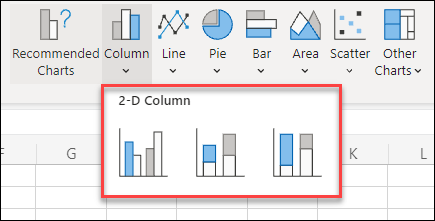
Tip:Your pick isn't applied until you pick an option from a Charts command menu. Consider reviewing several chart types: every bit y'all point to carte du jour items, summaries announced next to them to help you decide.
-
To edit the chart (titles, legends, data labels), select the Chart tab and then select Format.

-
In the Nautical chart pane, adjust the setting as needed. You can customize settings for the chart's title, legend, centrality titles, serial titles, and more.

Available chart types
Information technology's a good idea to review your data and determine what blazon of chart would work best. The bachelor types are listed below.
Information that's arranged in columns or rows on a worksheet can exist plotted in a column nautical chart. A column chart typically displays categories forth the horizontal axis and values along the vertical axis, like shown in this chart:
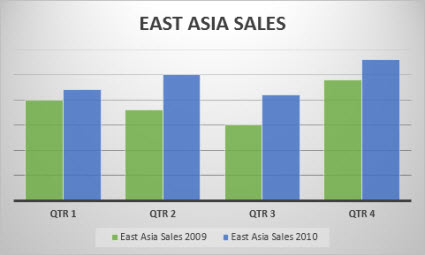
Types of column charts
-
Clustered columnA clustered column chart shows values in two-D columns. Apply this nautical chart when you have categories that stand for:
-
Ranges of values (for example, detail counts).
-
Specific scale arrangements (for example, a Likert scale with entries, like strongly agree, agree, neutral, disagree, strongly disagree).
-
Names that are not in any specific order (for example, item names, geographic names, or the names of people).
-
-
Stacked cavalcade A stacked cavalcade chart shows values in 2-D stacked columns. Utilise this chart when you take multiple data series and you desire to emphasize the total.
-
100% stacked cavalcadeA 100% stacked column nautical chart shows values in two-D columns that are stacked to represent 100%. Use this chart when you lot accept ii or more information series and you want to emphasize the contributions to the whole, especially if the total is the aforementioned for each category.
Data that is arranged in columns or rows on a worksheet can be plotted in a line chart. In a line nautical chart, category information is distributed evenly along the horizontal centrality, and all value data is distributed evenly along the vertical axis. Line charts can show continuous data over time on an evenly scaled centrality, and are therefore ideal for showing trends in data at equal intervals, like months, quarters, or financial years.
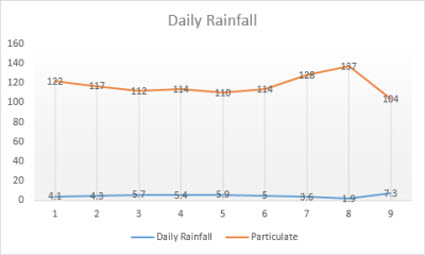
Types of line charts
-
Line and line with markersShown with or without markers to point private data values, line charts tin show trends over time or evenly spaced categories, especially when you have many data points and the order in which they are presented is of import. If there are many categories or the values are approximate, use a line chart without markers.
-
Stacked line and stacked line with markersShown with or without markers to bespeak private data values, stacked line charts can show the tendency of the contribution of each value over fourth dimension or evenly spaced categories.
-
100% stacked line and 100% stacked line with markersShown with or without markers to betoken individual data values, 100% stacked line charts tin show the trend of the percentage each value contributes over time or evenly spaced categories. If there are many categories or the values are judge, employ a 100% stacked line nautical chart without markers.
Notes:
-
Line charts work best when you have multiple data series in your chart—if you lot only have ane data series, consider using a scatter chart instead.
-
Stacked line charts add the data, which might non be the event you lot desire. Information technology might not exist piece of cake to see that the lines are stacked, and so consider using a different line nautical chart type or a stacked area nautical chart instead.
-
Data that is arranged in one cavalcade or row on a worksheet tin exist plotted in a pie chart. Pie charts show the size of items in ane data series, proportional to the sum of the items. The data points in a pie nautical chart are shown as a percentage of the whole pie.
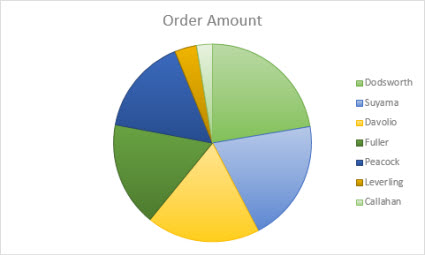
Consider using a pie chart when:
-
You take simply ane data series.
-
None of the values in your information are negative.
-
Well-nigh none of the values in your information are cypher values.
-
Yous accept no more than 7 categories, all of which represent parts of the whole pie.
Information that is bundled in columns or rows only on a worksheet can be plotted in a doughnut nautical chart. Like a pie chart, a doughnut chart shows the human relationship of parts to a whole, merely it can contain more than one data series.
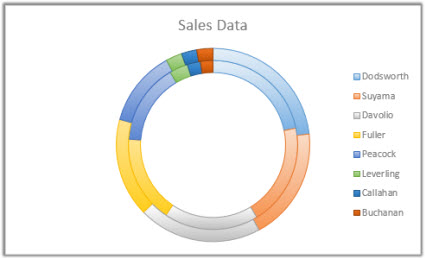
Tip:Doughnut charts are not easy to read. You lot may want to use a stacked column or stacked bar chart instead.
Data that is arranged in columns or rows on a worksheet can exist plotted in a bar nautical chart. Bar charts illustrate comparisons amongst individual items. In a bar nautical chart, the categories are typically organized forth the vertical axis, and the values forth the horizontal centrality.
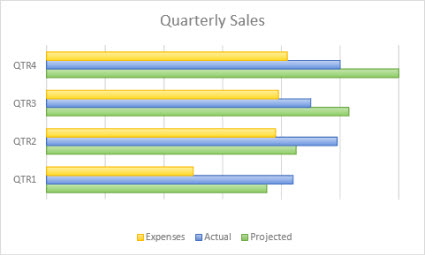
Consider using a bar chart when:
-
The axis labels are long.
-
The values that are shown are durations.
Types of bar charts
-
ClusteredA amassed bar chart shows bars in 2-D format.
-
Stacked barStacked bar charts show the relationship of private items to the whole in 2-D bars
-
100% stackedA 100% stacked bar shows 2-D bars that compare the percent that each value contributes to a total across categories.
Information that is bundled in columns or rows on a worksheet can be plotted in an expanse chart. Surface area charts can be used to plot alter over time and draw attention to the full value across a trend. By showing the sum of the plotted values, an expanse nautical chart too shows the relationship of parts to a whole.
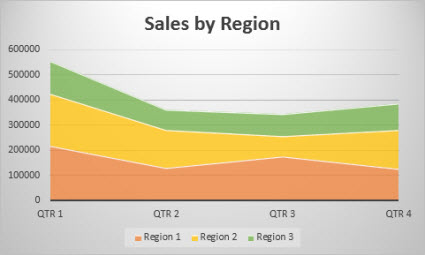
Types of expanse charts
-
Surface areaShown in 2-D format, area charts evidence the trend of values over time or other category data. As a rule, consider using a line chart instead of a non-stacked surface area chart, because data from one series can be subconscious behind information from some other serial.
-
Stacked areaStacked expanse charts bear witness the tendency of the contribution of each value over time or other category data in ii-D format.
-
100% stacked100% stacked area charts bear witness the trend of the percentage that each value contributes over time or other category data.
Information that is arranged in columns and rows on a worksheet can exist plotted in an scatter chart. Place the 10 values in one row or column, and then enter the respective y values in the adjacent rows or columns.
A scatter chart has two value axes: a horizontal (x) and a vertical (y) value centrality. It combines x and y values into single data points and shows them in irregular intervals, or clusters. Scatter charts are typically used for showing and comparison numeric values, like scientific, statistical, and engineering information.
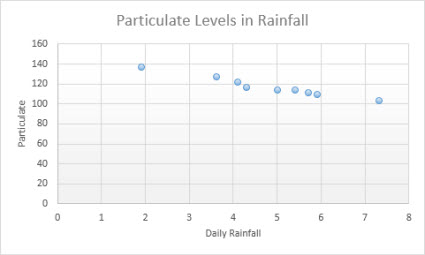
Consider using a scatter chart when:
-
Y'all want to modify the calibration of the horizontal axis.
-
You want to make that centrality a logarithmic calibration.
-
Values for horizontal axis are not evenly spaced.
-
There are many data points on the horizontal axis.
-
Yous want to adapt the independent axis scales of a scatter nautical chart to reveal more information about data that includes pairs or grouped sets of values.
-
You want to show similarities between large sets of data instead of differences between data points.
-
You desire to compare many data points without regard to time — the more data that you include in a scatter nautical chart, the ameliorate the comparisons y'all can brand.
Types of scatter charts
-
ScatterThis nautical chart shows data points without connecting lines to compare pairs of values.
-
Besprinkle with polish lines and markers and scatter with shine linesThis chart shows a smooth curve that connects the data points. Shine lines can be shown with or without markers. Use a smooth line without markers if there are many data points.
-
Scatter with directly lines and markers and scatter with direct linesThis chart shows straight connecting lines between data points. Straight lines can be shown with or without markers.
Data that is arranged in columns or rows on a worksheet can be plotted in a radar chart. Radar charts compare the amass values of several data series.
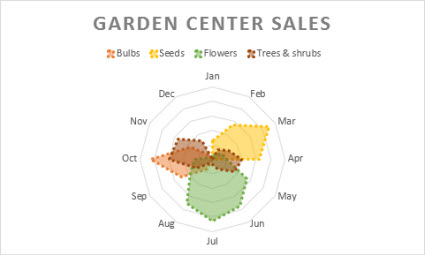
Type of radar charts
-
Radar and radar with markers With or without markers for individual data points, radar charts show changes in values relative to a center point.
-
Filled radarIn a filled radar chart, the expanse covered by a data series is filled with a colour.
Add together or edit a nautical chart championship
Yous can add or edit a chart championship, customize its look, and include it on the chart.
-
Click anywhere in the chart to show the Chart tab on the ribbon.
-
Click Formatto open the chart formatting options.

-
In the Nautical chart pane, expand theChart Title section.
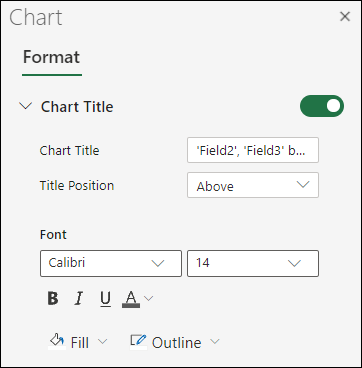
-
Add together or edit the Chart Title to meet your needs.
-
Use the switch to hide the title if you don't want your nautical chart to show a championship.
Add together centrality titles to improve chart readability
Calculation titles to the horizontal and vertical axes in charts that have axes can make them easier to read. You tin can't add axis titles to charts that don't have axes, such as pie and doughnut charts.
Much like chart titles, axis titles help the people who view the chart understand what the data is nigh.
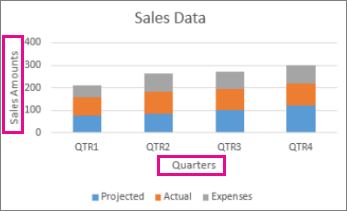
-
Click anywhere in the chart to show the Chart tab on the ribbon.
-
Click Formatto open the chart formatting options.

-
In the Nautical chart pane, expand the Horizontal Axis or Vertical Axissection.
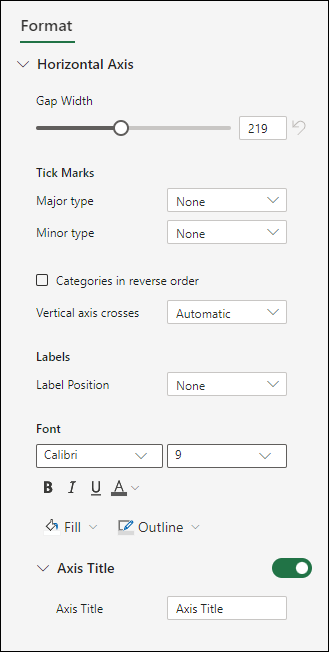
-
Add or edit the Horizontal Centrality or Vertical Axis options to meet your needs.
-
Expand the Axis Championship.

-
Change the Axis Championship and modify the formatting.
-
Apply the switch to show or hide the title.
Change the axis labels
Centrality labels are shown below the horizontal centrality and side by side to the vertical axis. Your nautical chart uses text in the source data for these axis labels.
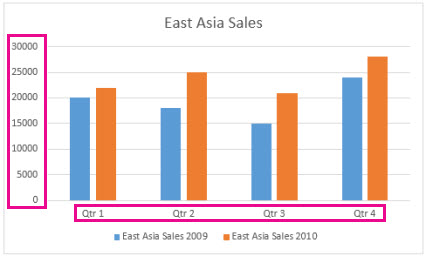
To change the text of the category labels on the horizontal or vertical axis:
-
Click the cell which has the label text you desire to change.
-
Type the text you want and press Enter.
The centrality labels in the chart are automatically updated with the new text.
Tip:Centrality labels are different from axis titles you can add to describe what is shown on the axes. Axis titles aren't automatically shown in a chart.
Remove the centrality labels
To remove labels on the horizontal or vertical centrality:
-
Click anywhere in the chart to bear witness the Chart tab on the ribbon.
-
Click Formatto open the nautical chart formatting options.

-
In the Chart pane, expand the Horizontal Axis or Vertical Axissection.

-
From the dropdown box for Label Position, select None to prevent the labels from showing on the chart.

Demand more than help?
You can ever enquire an expert in the Excel Tech Community or get support in the Answers community.
Source: https://support.microsoft.com/en-us/office/create-a-chart-from-start-to-finish-0baf399e-dd61-4e18-8a73-b3fd5d5680c2
Posted by: allenbutia1993.blogspot.com


0 Response to "How To Make A Time Sensitive Graph On Excel"
Post a Comment